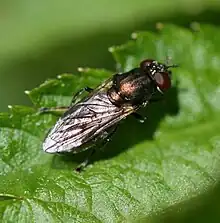| Orthonevra nobilis | |
|---|---|
 | |
| Female | |
| Scientific classification | |
| Domain: | Eukaryota |
| Kingdom: | Animalia |
| Phylum: | Arthropoda |
| Class: | Insecta |
| Order: | Diptera |
| Family: | Syrphidae |
| Genus: | Orthonevra |
| Species: | O. nobilis |
| Binomial name | |
| Orthonevra nobilis (Fallén, 1817) | |
| Synonyms | |
Description
External images
For terms see Morphology of Diptera
Wing length 4-5 ·75 mm. White marks on face extend narrowly downwards. Pterostigm dark brown or black. Antennomere 3 pointed Female tergite 5 with a small incision at hind margin.
van der Goot (1981) figures the male genitalia. The larva is described and figured by Maibach and Goeldlin (1994).[3]
Distribution
Palearctic Range: Central Fennoscandia, South to Central Spain. Ireland, East North Europe and Central Europe and North Italy. East into Yugoslavia, Greece and Turkey European Russia and the Caucasus, the Russian Far East, Siberia and North China.[8][9]
Biology
Habitat: Streams in Fagus woodland, riparian gallery forest, springs and flushes in fen and raised bog.[10] Flowers visited include white umbellifers, Fragaria, Galium, Potentilla erecta, Ranunculus.[11] The flight period is May/ to August.The larva is associated with springs and flushes, where it occurs in wet, organically-enriched mud.
References
- ↑ Stubbs, Alan E.; Falk, Steven J (1983). British Hoverflies: An Illustrated Identification Guide (2nd ed.). London: British Entomological and Natural History Society. pp. 253, xvpp. ISBN 1-899935-03-7.
- ↑ Ball, S.G.; Morris, R.K.A. (2000). Provisional atlas of British hoverflies (Diptera, Syrphidae). Monks Wood, UK: Biological Record Centre. pp. 167 pages. ISBN 1-870393-54-6.
- ↑ Maibach, A. & Goeldlin de Tiefenau, P. (1994) Limites génériques et caractéristiques taxonomiques de plusieurs genres de la Tribu des Chrysogasterini (Diptera: Syrphidae) III. Descriptions des stades immatures de plusieurs espèces ouest-paléarctiques. Rev.suisse Zool., 101: 369-411).
- ↑ Van Veen, M. (2004) Hoverflies of Northwest Europe: identification keys to the Syrphidae. 256pp. KNNV Publishing, Utrecht.addendum
- ↑ Van der Goot,V.S. (1981) De zweefvliegen van Noordwest - Europa en Europees Rusland, in het bijzonder van de Benelux. KNNV, Uitgave no.32: 275pp. Amsterdam.
- ↑ Bei-Bienko, G.Y. & Steyskal, G.C. (1988) Keys to the Insects of the European Part of the USSR, Volume V: Diptera and Siphonaptera, Part I. Amerind Publishing Co., New Delhi. ISBN 81-205-0080-6.
- ↑ Coe, R.L. (1953) Diptera: Syrphidae. Handbks.ident.Br.insects, 10(1): 1-98. R.ent.Soc.London. pdf
- ↑ Fauna Europaea
- ↑ Peck, L.V. (1988) Syrphidae. In: Soos, A. & Papp, L. (eds.) Catalogue of Palaearctic Diptera, 8: 11-230. Akad.Kiado, Budapest.
- ↑ Speight, M.C.D. (2011). "Species accounts of European Syrphidae (Diptera)" (PDF). Syrph the Net, the database of European Syrphidae. 65: 285pp.
- ↑ de Buck, N. (1990) Bloembezoek en bestuivingsecologie van Zweefvliegen (Diptera, Syrphidae) in het bijzonder voor België. Doc.Trav. IRSNB, no.60, 1-167.